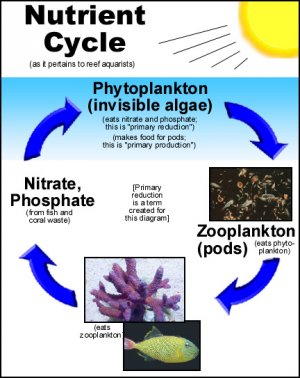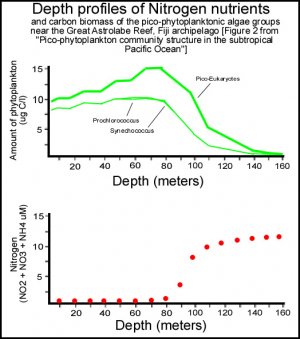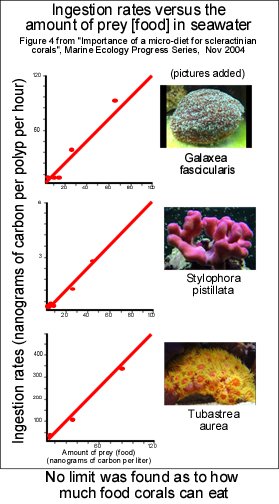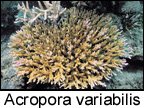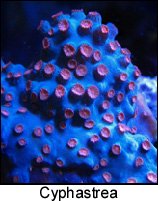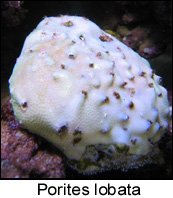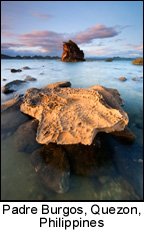"The other half of the story."
"Reef aquarists hopefully now understand that they can greatly increase their coral growth by feeding plankton (and lots of it) to their tanks. And especially, by feeding the plankton slowly throughout the night (not all at once), which is when and how corals eat the most."
"But a problem arises in aquariums: Water quality. Anyone who has tried heavy coral feeding, or maybe any coral feeding at all, has seen their water quality go down quickly, because the uneaten food starts rotting and generating nitrates and phosphates. Not only do you have to stop the feeding, but the water quality then needs to be fixed so that the corals can at least get back to growing the way they were originally (bad water quality can slow down or stop coral growth). This is not a problem in the ocean, because even with the gigantic amounts of food that is fed to the corals, the ocean has its own nitrate and phosphate filters, and it does the filtering quite quickly. So what can you do?"
"Copy the ocean, that's what. This means copy the ocean exactly, they way it processes its own water quality. It's easy, and you might already be doing it; or maybe you just need to do it more. It starts by understanding the most important process in the ocean: Primary Production."
"Primary Production is one of the most commonly used terms in ocean science, and it occurs when phytoplankton grows in sunlight. It is called "primary" because it's the "first step" or the "bottom" of the food chain, and it eventually feeds everything in the ocean. Everything. Including corals. Also, it makes all the oxygen on the earth (and in the water too, of course). Phytoplankton can do this because it grows from the surface of the ocean down to about 300 feet, and it grows in every ocean, lake, stream, river and puddle on the earth. It's 90 percent of all life in the ocean (besides bacteria); The remaining 10 percent is everything else: Whales, corals, fish, crabs, zooplankton, etc."
"In the ocean, phytoplankton grows and gets eaten mostly by zooplankton; and of the zooplankton, copepods are the most abundant animals in the ocean. About 90 percent of all pods in the ocean are copepods. And of course the copepods, along with other zooplankton, are food for most of the corals that reefers want to keep in their tanks. But how does this fix the water quality?"
"Well, among a few other things, phytoplankton uses two very important things to grow: nitrate and phosphate. So while phytoplankton is producing food IN the water, it's also using (reducing) nitrate and phosphate FROM the water. How convenient! It is exactly what is needed. Matter of fact, since phytoplankton covers the top 300 feet of depth of the ocean (which is where all the sunlight is), this 300 feet happens to also be the lowest-nitrate and lowest-phosphate area of the ocean (see attached graph). So, we thought of a not-so-scientific term to help reefers understand this process: Primary Reduction. Primary Reduction occurs when phytoplankton reduces the amount of nitrate and phosphate in the ocean, while making (producing) food for the ocean. In case you can't see the graph, here are typical nitrate and phosphate measurements from the ocean; as you can see, there is almost no nitrate or phosphate in the top 300 feet of water, because the phytoplankton there eats it all:"
Depth (meters)......Phytoplankton Amount (ugC/l)..........NO2+NO3+NH4 (uM)
10.......................10....................................Almost zero
20.......................11....................................Almost zero
30.......................12....................................Almost zero
40.......................12....................................Almost zero
50.......................13....................................Almost zero
60.......................13....................................Almost zero
70.......................15....................................Almost zero
80.......................15....................................1
90.......................13....................................4
100.......................12...................................9
110.......................5....................................10
120.......................4....................................11
130.......................3....................................11.5
140.......................1....................................11.7
150.......................0.5..................................11.9
160.......................0....................................12
"Primary Reduction is the main process by which the ocean and the reefs remove nitrate and phosphate from the water. It's really the same thing as Primary Production, it's just looking at it from a different viewpoint. "Production" is what is made; "Reduction" is what is removed. It's kind of like when you make a sandwich: You "produce" a sandwich, but you "reduce" the amount of bread remaining in the house. Scientific studies use the term Primary Production to mean both production and reduction, because it's understood (it's one of the first things you learn in ocean science) that phytoplankton uses lots of nitrate and phosphate to grow. Reefers, however, don't all know this yet, so we hope the term Primary Reduction helps in the understanding."
"Continuing with the sandwiches: If your goal were to "reduce" the amount of bread in your house as much as possible, you'd want to "produce" as many sandwiches as possible, even if you had to give the sandwiches away to other people. This way, at least your "excess bread problem" would be gone. You of course would eat a few sandwiches, so you'd have energy to keep on "producing more sandwiches" and "reducing more bread". And as long as you did this, you could keep the bread-reduction process going forever. You might call this a "sandwich cycle", and indeed it's very similar to how it's done in the ocean, except there it's called the Nutrient Cycle."
"The Nutrient Cycle (also called a Carbon Cycle) is how the ocean gets rid of all the nitrate and phosphate that builds up in the water (the attached color diagram shows how it looks). Primary Production uses the sun to grow phytoplankton, which makes food to feed the copepods and then the larger animals. The waste from these animals makes nitrate and phosphate, which then gets removed from the water by the phytoplankton's Primary Reduction. But Primary Reduction is really the same thing as Primary Production. So you repeat. The only "outside" thing needed to keep the Nutrient Cycle going is light. In case you can't see the diagram, it works like this:"
"phytoplankton -> zooplankton -> fish+corals -> nitrate+phosphate -> phytoplankton"
"The Nutrient Cycle is not the same as the Nitrogen Cycle; the Nitrogen Cycle is just one specific part of the whole Nutrient Cycle. If you only complete the Nitrogen Cycle, but don't complete the whole Nutrient Cycle, then nitrate and phosphate will build up and cause problems, such as the nutrient problems that many reefers have in their tanks."
"In the ocean, the Nutrient Cycle is a tight circular cycle like the attached picture shows. This is true especially on reefs, where a large part of the nutrients stay "on the reef" and do not flow out into the ocean; the nutrients are just recycled in the Nutrient Cycle. This make reefs one of the most efficient users of energy on earth, because all the nutrients stay on the reef, and it also explains Darwin's Paradox: How can so much life exist on a reef, when there are so little nutrients there."
"(Note: Depending on the area of science that you read, primary production is also described as nitrogen fixing, carbon fixing, CO2 fixing, and photosynthesis.)"
"Videos we like:
Phytoplankton sampling in the Antarctic:
http://www.youtube.com/watch?v=5V6kvCXLf8Q
UK phyto sampling:
http://www.youtube.com/watch?v=NmQeXMNXxEo
And the video which ties everything together:
http://www.youtube.com/watch?v=jPOYJIt0pbc "
Link:
http://www.reefbase.org/download/download.aspx?type=10&docid=A0000001891_1 (needs free account)


